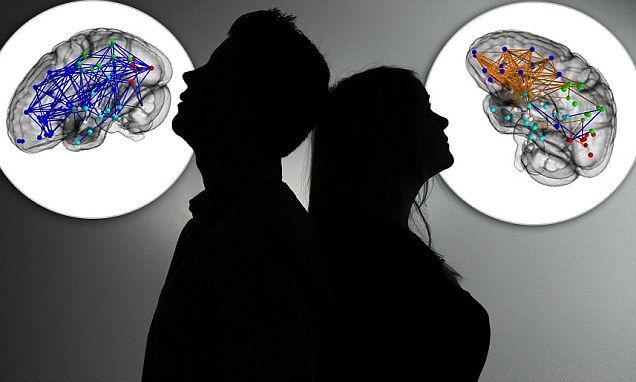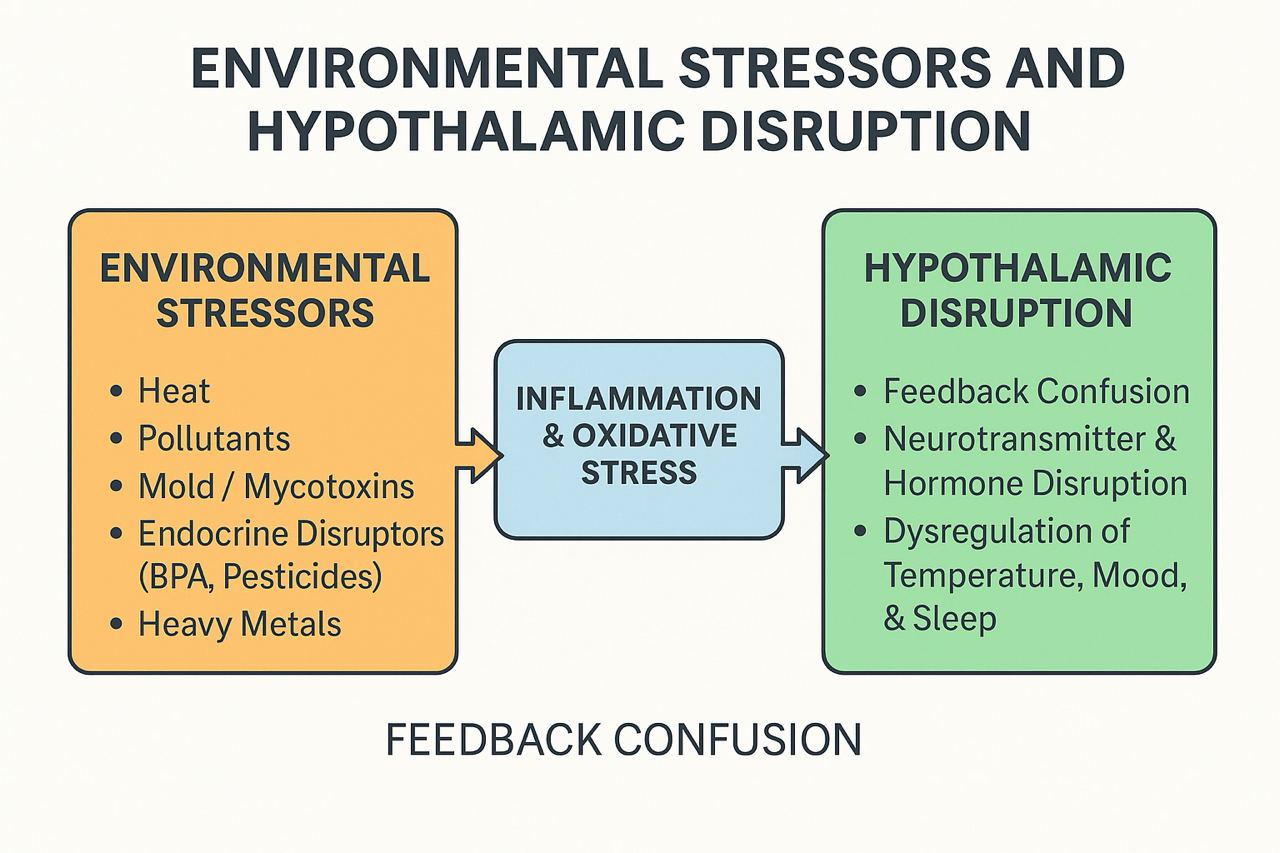It’s Not Just Hormones: The Hidden Environmental Triggers Behind Hot Flashes in Men and Women

When the Body’s Thermostat Breaks: How Environmental Toxins Can Cause Hot Flashes in Men and Women
Hot flashes are often viewed as a symptom exclusive to menopause — a fleeting, uncomfortable surge of heat linked to hormonal changes in women. Yet, more people today under the age of 30, including men, are experiencing chronic heat surges, night sweats, and thermoregulatory instability without any direct hormonal cause. Emerging evidence suggests that environmental stressors and toxic exposures may play a major role by disrupting the brain’s temperature control center — the hypothalamus.
The Hypothalamus: The Body’s Thermostat
The hypothalamus regulates temperature, hunger, thirst, sleep, and hormonal balance. It constantly receives sensory feedback about internal conditions — like body heat or blood sugar — and sends signals to maintain equilibrium.
When the hypothalamus detects overheating, it activates cooling mechanisms such as sweating and vasodilation (widening of blood vessels). When cold, it triggers shivering and vasoconstriction to conserve warmth. This precise balancing act, called homeostasis, depends on healthy neural and hormonal communication.
However, this balance can be thrown off by environmental factors that cause inflammation, oxidative stress, or hormonal interference in the hypothalamus.
The Chain Reaction
Environmental stressors → Inflammation & oxidative stress → Hypothalamic feedback confusion →
Misfiring of cooling mechanisms (sweating, vasodilation) → Hot flashes and thermoregulatory instability
This is exactly what your diagram illustrates: the process that transforms constant environmental pressure into physiological chaos.

⚗️ Environmental and Toxic Triggers and toxic loop.
A growing number of studies link chronic exposure to pollutants and synthetic chemicals with hypothalamic dysfunction. Here are the main culprits:
1. Endocrine Disruptors (BPA, Phthalates, PFAS, Dioxins)
Found in plastics, canned food linings, cosmetics, and nonstick cookware, these chemicals mimic natural hormones such as estrogen and testosterone.
-
They bind to hormone receptors in the brain, confusing feedback loops that control temperature and stress.
-
BPA and phthalates, for instance, alter gene expression in hypothalamic neurons that regulate metabolism and thermoregulation.
-
The result: the brain misreads temperature signals, leading to hot flashes, night sweats, and heat intolerance.
2. Air Pollution and Particulate Matter
Fine particles (PM2.5, PM10) from vehicle exhaust, industry, or wildfires can penetrate the blood-brain barrier, causing neuroinflammation.
-
The hypothalamus, rich in blood vessels, becomes a direct target for oxidative stress.
-
This inflammation alters neurotransmitters like serotonin and dopamine, which play a role in body temperature and mood regulation.
-
Over time, it can mimic or worsen menopausal and andropausal symptoms.
3. Mold and Mycotoxins
Indoor mold exposure releases mycotoxins that affect the hypothalamic–pituitary–adrenal (HPA) axis.
-
This axis regulates cortisol and other stress hormones.
-
Disruption leads to exaggerated sympathetic (“fight-or-flight”) responses, including sweating, heart palpitations, and heat surges.
-
Some individuals with mold sensitivity report years of temperature instability even after leaving the exposure.
4. Pesticides
Organophosphate and carbamate pesticides inhibit acetylcholinesterase, an enzyme essential for proper nerve signaling.
-
This overstimulation of neurons can cause hot flashes, anxiety, and abnormal sweating.
-
Chronic exposure also triggers oxidative stress, damaging temperature-regulating neurons in the hypothalamus.
5. Heavy Metals (Lead, Mercury, Arsenic, Cadmium)
Heavy metals accumulate in the brain and interfere with hypothalamic signaling.
-
Mercury binds to sulfhydryl groups in neural proteins, impairing electrical communication.
-
Lead affects calcium channels needed for neurotransmitter release.
-
These changes blunt the hypothalamus’s ability to sense and regulate temperature, often producing heat intolerance, chills, or spontaneous sweating.
How This Causes Hot Flashes
Despite different origins, all these stressors follow a common pathway:
-
Environmental toxin or pollutant exposure →
-
Inflammation and oxidative stress in the brain →
-
Altered neurotransmitter and hormonal feedback →
-
Hypothalamus misreads normal temperature signals →
-
Erroneous activation of cooling mechanisms (sweating, flushing, vasodilation)
The end result? Hot flashes, even without a hormonal trigger.
In women, this amplifies menopausal symptoms.
In men, it can mimic low-testosterone symptoms or occur independently due to neural inflammation.
️ Why Some People Are More Affected
Not everyone exposed to pollutants develops hot flashes. The difference often lies in:
-
Genetic detox capacity (liver and glutathione pathways)
-
Cumulative lifetime exposure
-
Chronic stress or poor sleep, which heighten sympathetic nervous activity
-
Metabolic conditions (thyroid disorders, insulin resistance) that add stress to hypothalamic regulation
People with multiple overlapping factors are more likely to experience long-lasting, unexplained thermoregulatory symptoms.
Protecting the Body’s Thermostat
Although total avoidance of environmental toxins is impossible, the effects can be reduced:
-
Improve air quality: use HEPA filters indoors, avoid smoke exposure.
-
Avoid plastics: switch to glass, ceramic, or stainless steel for food and drinks.
-
Limit pesticide residues: wash produce, choose organic when possible.
-
Support detoxification: stay hydrated, eat antioxidant-rich foods (cruciferous vegetables, citrus, berries).
-
Reduce chronic stress: sleep, exercise, and breathing techniques strengthen the HPA axis.
Conclusion
Hot flashes aren’t always a hormonal mystery. They can also be the body’s alarm signal that environmental stress has overwhelmed its internal thermostat. Whether caused by pollution, mold, or everyday chemicals, these exposures disrupt the brain’s most ancient balancing mechanism — the hypothalamus.
Understanding this connection offers a more complete view of why both men and women today are reporting chronic heat intolerance — and why protecting brain and environmental health is key to restoring balance.





